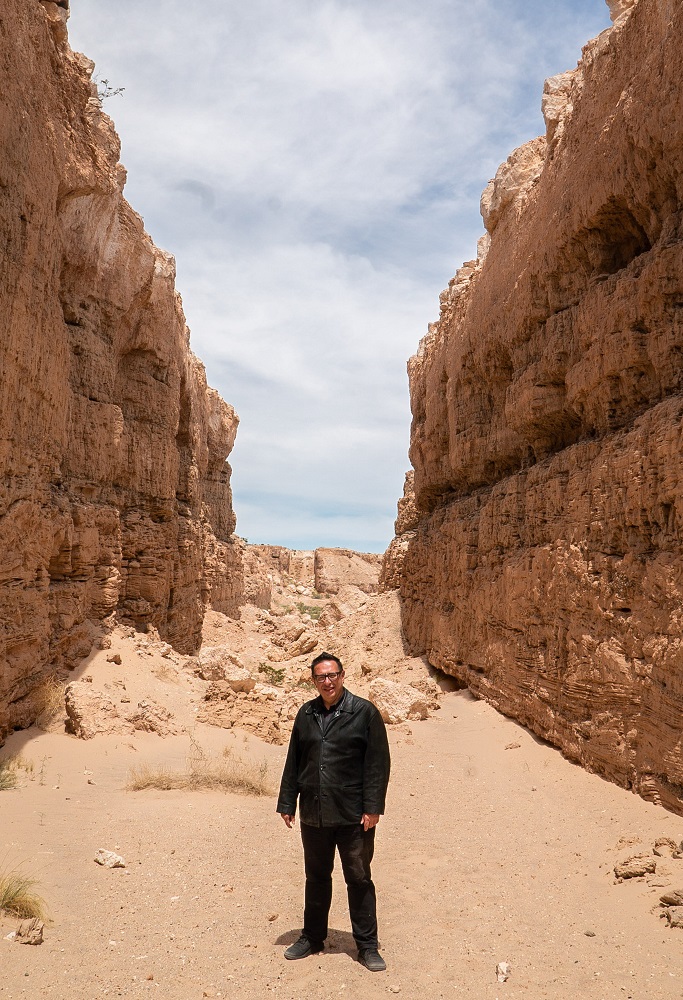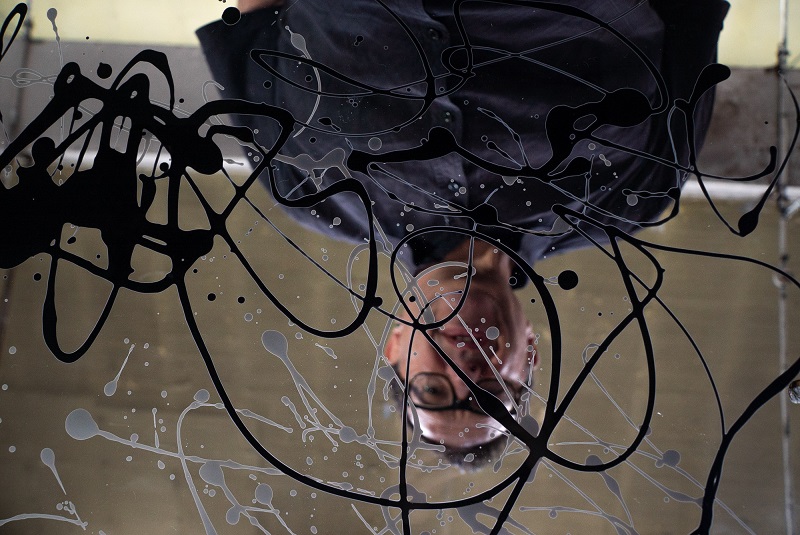Big Sky Big Dreams Big Art Made in the Usa
"Oh say, can you run across, by the dawn's early on light" was a vision of the American flag, that star-spangled imprint, riding proud from Francis Scott Cardinal's patriotic poem of 1814 based on an episode in the War of 1812.
His sentiments were decades subsequently rather improbably set to the tune of a popular drinking vocal from a London gentlemen's club, metamorphosing into the official American national canticle by Act of Congress in 1931 – you couldn't make it up.
That was but i of the unexpected facts in Waldemar Januszczak's three-part foray into the special nature, as he sees it, of American fine art: as in his contempo work, WJ the presenter doubled as WJ the director. It started with a foray into the Wild W, with side excursions to New York and Los Angeles. The scene was set with quotes from DH Lawrence, some other English consign, who spent fourth dimension in New Mexico and eloquently pondered the notions of the spirit of place. WJ wandered through some of the most dramatic landscapes of Due north America, telling usa that the spirit of identify is always in the art, as he headed toward what he characterised as the "Promised Land". He stressed the unique qualities of that landscape, challenge its dramas and the late 20th century phenomenon of land art could only happen in America. A rather hubristic suggestion? What nearly the Nazca lines in Peru or the stone-hewn Buddhist caves on Mainland china's Silk Road: contemporary state art follows a long tradition.
The wild, we were finally told, is largely a piece of work of fiction: what yous see is what you want to see
To give WJ his due nosotros had some marvellous glimpses of Navajo and other Native Indian petroglyphs and pictographs, millennia-onetime carvings and paintings on rock to be found in the deserts of the southwest. Native Americans evidently entered the dream world and came back with images. (But so did the artists of southern Africa and Commonwealth of australia.)
Land art – fitting art to the identify. WJ was in search of naught less than the spirit of America, introduced by a montage of Grant Woods and American Gothic, George Bellows' boxers, Mark Rothko'southward transcendent sublime rectangles of glowing colour, and Edward Hopper's Nighthawks, not to mention the hero of this episode, Jackson Pollock. Whose kickoff name, guess what, was Paul.
The identity of American fine art was attached to that astonishing creation Spiral Jetty, a one,500-human foot-long spiral of rocks gear up past Robert Smithson in 1970 into Utah'southward Great Salt Lake; one of the great visual pleasures of this programme was seeing its various incarnations over the years, as the jetty was exposed by the falling levels of the water and re-emerged encrusted in table salt, a snow storm in the desert. Information technology was drowned, disappeared and so reappeared.
 Afterwards we witnessed the aging Double Negative by Michel Heizer, where the artist created an artificial canyon with bulldozers, stretching i,500 feet (something magic most that tertiary-of-a-mile effigy?) and digging out 240,000 tons of rock in the process (pictured correct, with the presenter in his trademark black). Simply James Turrell'due south remodelled volcano and Walter de Maria'southward Lightning Field didn't get a mention, nor the fact that land fine art seems to have reached an impasse.
Afterwards we witnessed the aging Double Negative by Michel Heizer, where the artist created an artificial canyon with bulldozers, stretching i,500 feet (something magic most that tertiary-of-a-mile effigy?) and digging out 240,000 tons of rock in the process (pictured correct, with the presenter in his trademark black). Simply James Turrell'due south remodelled volcano and Walter de Maria'southward Lightning Field didn't get a mention, nor the fact that land fine art seems to have reached an impasse.
But we should be grateful for the less familiar, including the 19th century landscape painter Thomas Moran, who came from Lancashire every bit a child and ended up with American sublime, painting the Grand Canyon, Mt Cross Mount in Colorado, and Yellowstone. The federal government bought a painting of the last for $ten,000 and, inspired by this visionary landscape, was prompted to claim Yellowstone as the world'south first national park in 1872. We also saw the art of that Easterner-turned-Westerner Frederic Remington, the painter and sculptor of cowboys, making the myths visible.
Western myths figured ever larger as WJ stood stalwart in a re-enactment of a shoot-out between goodies and baddies, bandits and sheriffs, in the dusty main street of a Wild West boondocks in the middle of nowhere (primary moving picture). This was Cody, Wyoming, named after Buffalo Pecker and where Paul Jackson Pollock was born, his begetter a badly paid worker in the Irma hotel. Subsequently the family migrated to the City of Angels: at the High School of Manual Arts immature Pollock, always a rebel teamed up with a kindred spirit – Philip Goldstein, later Philip Guston, later a leader of the New York School. Then it was on to theosophy, that impenetrable edifice of mysterious thought, preached on the West Coast by Krishnamurti, its cascades of words provided by Madame Blavatsky, and embraced by abstract painters including Kandinsky and Mondrian, not to mention Guston and Pollock. Information technology was all getting a bit much.
In betwixt, there was a side trip to United mexican states City, the great city of fine art – move over New York, Paris, St Petersburg! – where a Dominican convent became the Ministry of Pedagogy, complete with the astonishing murals of Diego Rivera, 235 fresco panels, the Sistine Chapel of the Americas painted in the 1920s. But what of the Riveras in the US, and the rows with capitalism when his left-leaning mural created for New York's Rockefeller Heart in the 1930s was destroyed, only to be recreated later and now on permanent display in the Museum of Fine Fine art in United mexican states Metropolis.
Merely anything that brings Rivera'due south magnificent visual inventions, mesmerising social criticisms embodied in magnificent wall paintings, to our attention is a brilliant televisual bonus. Especially welcome now that the US has become the land of Trump, merely quite what the achievements of Mexico have to practise with WJ's indicate about American art was a piffling disruptive: no mention of the political idealism of fine art supported at the time of the New Deal in the 1930s Depression.
Some other bonus was the examination of the socially critical and complex art of Thomas Hart Benton, a regionalist painter who taught Pollock in New York: vintage picture showed Benton actually composing by drawing and fifty-fifty modelling in clay a vital abstract choreography of flowing shapes which underlay his vivid and emotional human dramas.
What is conventionally hailed as the start actually American art, Abstract Expressionism, turned upwards with Pollock re-imagining that Wild W in abstract terms. A neat conceit was Benton's abstraction overlaid with detailed figuration, whilst Pollock is the contrary, the rhythms of a herd of mustangs subsumed into the glories of his creations of dripped and flung paint. (Pictured above: Waldemar attempts to paint like Jackson Pollock; image, Matt Conway)
The wild, we were finally told, is largely a work of fiction: what you meet is what y'all want to see, the visible earth cloaking something much bigger, the artist the conduit. The trouble here was making a theory to fit the facts, and an all-too-facile buying into the American myth with untempered enthusiasm from an observer intellectually inebriated by the vast beauties of the deserts of the southwest.
- Read more Tv reviews on theartsdesk
brookscamvintat2000.blogspot.com
Source: https://theartsdesk.com/tv-visual-arts/big-sky-big-dreams-big-art-made-usa-bbc-four-review-unexpected-facts-aplenty
0 Response to "Big Sky Big Dreams Big Art Made in the Usa"
Post a Comment